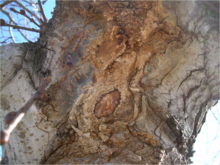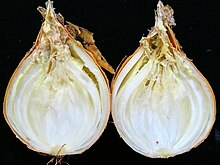| Pectobacterium carotovorum | |
|---|---|

| |
| Slime flux on a Camperdown elm caused by Pectobacterium carotovorum | |
| Scientific classification | |
| Domain: | Bacteria |
| Phylum: | Pseudomonadota |
| Class: | Gammaproteobacteria |
| Order: | Enterobacterales |
| Family: | Pectobacteriaceae |
| Genus: | Pectobacterium |
| Species: | P. carotovorum
|
| Binomial name | |
| Pectobacterium carotovorum (Jones 1901) Waldee 1945
| |
| Subspecies | |
| |
| Synonyms | |
|
Erwinia carotovora | |

Pectobacterium carotovorum is a bacterium of the family Pectobacteriaceae; it used to be a member of the genus Erwinia.[1]
The species is a plant pathogen with a diverse host range, including many agriculturally and scientifically important plant species. It produces pectolytic enzymes that hydrolyze pectin between individual plant cells. This causes the cells to separate, a disease plant pathologists term bacterial soft rot. Specifically, it causes beet vascular necrosis and blackleg of potato and other vegetables (hence the name carotovora – "carrot-eater"), as well as slime flux on many different tree species.[2] Currently, there are four described subspecies of P. carotovorum (carotovorum, brasiliense, odoriferum, and actinidiae).[3]
This bacterium is a ubiquitous plant pathogen with a wide host range (carrot, potato, tomato, leafy greens, squash and other cucurbits, onion, green peppers, African violets, etc.), able to cause disease in almost any plant tissue it invades. It is a very economically important pathogen in terms of post-harvest losses, and a common cause of decay in stored fruits and vegetables. Decay caused by P. carotovora is often referred to as "bacterial soft rot" though this may also be caused by other bacteria. Most plants or plant parts can resist invasion by the bacteria, unless some type of wound is present. High humidity and temperatures around 30 °C (86 °F) favor development of decay. The cells become highly motile near this temperature (26 °C (79 °F)) when fructose is present.[4] Mutants can be produced which are less virulent. Virulence factors include: pectinases, cellulases, (which degrade plant cell walls), and also proteases, lipases, xylanases, and nucleases (along with the normal virulence factors for pathogens – Fe acquisition, lipopolysaccharide (LPS) integrity[specify], multiple global regulatory systems).
- ^ Toth, Ian; Bell, Kenneth; Holeva, Maria; Birch, Paul (2003). "Soft rot erwiniae: from genes to genomes". Pathogen profile. Molecular Plant Pathology. 4 (1). Blackwell Publishing Ltd.: 17–30. doi:10.1046/j.1364-3703.2003.00149.x. ISSN 1364-3703. PMID 20569359. S2CID 37973919. British Society for Plant Pathology (BSPP).
- ^ Toth, Ian K.; Bell, Kenneth S.; Holeva, Maria C.; Birch, Paul R. J. (1 January 2003). "Soft rot erwiniae: from genes to genomes". Molecular Plant Pathology. 4 (1): 17–30. doi:10.1046/j.1364-3703.2003.00149.x. PMID 20569359.
- ^ This review... Zeng, Yuan; Charkowski, Amy (2021). "The Role of ATP-Binding Cassette Transporters in Bacterial Phytopathogenesis". Phytopathology. 111 (4). American Phytopathological Society (APS): 600–610. doi:10.1094/phyto-06-20-0212-rvw. ISSN 0031-949X. ...cite this study: Li, Lei; Yuan, Lifang; Shi, Yanxia; Xie, Xuewen; Chai, Ali; Wang, Qi; Li, Baoju (2019). "Comparative genomic analysis of Pectobacterium carotovorum subsp. brasiliense SX309 provides novel insights into its genetic and phenotypic features". BMC Genomics. 20 (1). BMC: 486. doi:10.1186/s12864-019-5831-x. ISSN 1471-2164. PMC 6567464. PMID 31195968. S2CID 255817156. S2CID 189763708.
- ^ Aizawa, Shin-Ichi (2014). "Pectobacterium carotovorum — Subpolar Hyper-Flagellation". The Flagellar World. Elsevier. pp. 58–59. doi:10.1016/b978-0-12-417234-0.00018-9. ISBN 9780124172340.